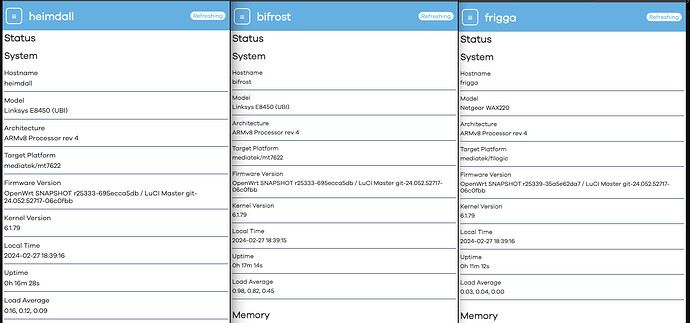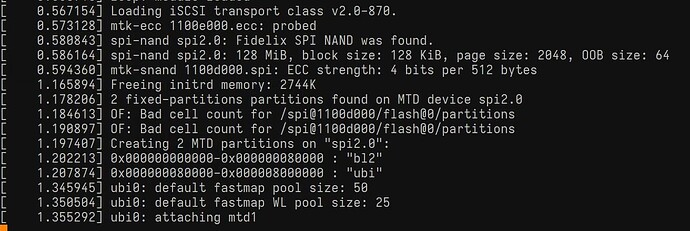Yes, both in the normal boot, and I see it in the logs from the re-installer.
normal boot:
reinstaller:
Writing from /installer/mt7622-snand-ubi-1ddr-bl2.img to /dev/mtd0 ...
ubiformat: mtd1 (nand), size 133693440 bytes (127.5 MiB), 1020 eraseblocks of 131072 bytes (1s
libscan: scanning eraseblock 1019 -- 100 % complete
ubiformat: 999 eraseblocks have valid erase counter, mean value is 0
ubiformat: 11 eraseblocks are supposedly empty
ubiformat: 1 bad eraseblocks found, numbers: 638
ubiformat: warning!: 9 of 1019 eraseblocks contain non-UBI data
u[ 14.137615] platform 1b100000.ethernet: deferred probe pending
ubiformat: formatting eraseblock 1019 -- 100 % complete
[ 15.548260] ubi0: default fastmap pool size: 50
[ 15.552815] ubi0: default fastmap WL pool size: 25
[ 15.557651] ubi0: attaching mtd1
[ 15.871031] ubi0: scanning is finished
[ 15.879484] ubi0: attached mtd1 (name "ibu", size 127 MiB)
[ 15.884985] ubi0: PEB size: 131072 bytes (128 KiB), LEB size: 126976 bytes
[ 15.891887] ubi0: min./max. I/O unit sizes: 2048/2048, sub-page size 2048
[ 15.898680] ubi0: VID header offset: 2048 (aligned 2048), data offset: 4096
[ 15.905634] ubi0: good PEBs: 1019, bad PEBs: 1, corrupted PEBs: 0
[ 15.911723] ubi0: user volume: 0, internal volumes: 1, max. volumes count: 128
[ 15.918946] ubi0: max/mean erase counter: 2/1, WL threshold: 4096, image sequence number: 1
[ 15.928077] ubi0: available PEBs: 994, total reserved PEBs: 25, PEBs reserved for bad PEB 9
[ 15.937392] ubi0: background thread "ubi_bgt0d" started, PID 472
UBI device number 0, total 1019 LEBs (129388544 bytes, 123.3 MiB), available 994 LEBs (126214)
Volume ID 0, size 9 LEBs (1142784 bytes, 1.0 MiB), LEB size 126976 bytes (124.0 KiB), static,1
Volume ID 1, size 5 LEBs (634880 bytes, 620.0 KiB), LEB size 126976 bytes (124.0 KiB), static1
[ 17.541485] OF: Bad cell count for /spi@1100d000/flash@0/partitions
Volume ID 2, size 1 LEBs (126976 bytes, 124.0 KiB), LEB size 126976 bytes (124.0 KiB), dynami1
[ 17.563591] OF: Bad cell count for /spi@1100d000/flash@0/partitions
Volume ID 3, size 1 LEBs (126976 bytes, 124.0 KiB), LEB size 126976 bytes (124.0 KiB), dynami1
write recovery ubi volume
Volume ID 4, size 56 LEBs (7110656 bytes, 6.7 MiB), LEB size 126976 bytes (124.0 KiB), dynami1
[ 19.214627] block ubiblock0_5: created from ubi0:5(fit)
Volume ID 5, size 1 LEBs (126976 bytes, 124.0 KiB), LEB size 126976 bytes (124.0 KiB), dynami1
writing backup files to ubi volume...
Volume ID 6, size 67 LEBs (8507392 bytes, 8.1 MiB), LEB size 126976 bytes (124.0 KiB), dynami1
[ 19.247577] UBIFS (ubi0:6): default file-system created
[ 19.253137] UBIFS (ubi0:6): Mounting in unauthenticated mode
[ 19.258950] UBIFS (ubi0:6): background thread "ubifs_bgt0_6" started, PID 516
[ 19.287944] UBIFS (ubi0:6): UBIFS: mounted UBI device 0, volume 6, name "boot_backup"
[ 19.295787] UBIFS (ubi0:6): LEB size: 126976 bytes (124 KiB), min./max. I/O unit sizes: 20s
[ 19.305720] UBIFS (ubi0:6): FS size: 7237632 bytes (6 MiB, 57 LEBs), max 67 LEBs, journal )
[ 19.316947] UBIFS (ubi0:6): reserved for root: 341850 bytes (333 KiB)
[ 19.323402] UBIFS (ubi0:6): media format: w5/r0 (latest is w5/r0), UUID DE3E1E41-6DA7-428El
[ 19.643187] UBIFS (ubi0:6): un-mount UBI device 0
[ 19.647986] UBIFS (ubi0:6): background thread "ubifs_bgt0_6" stops
[ 24.698420] reboot: Restarting system

